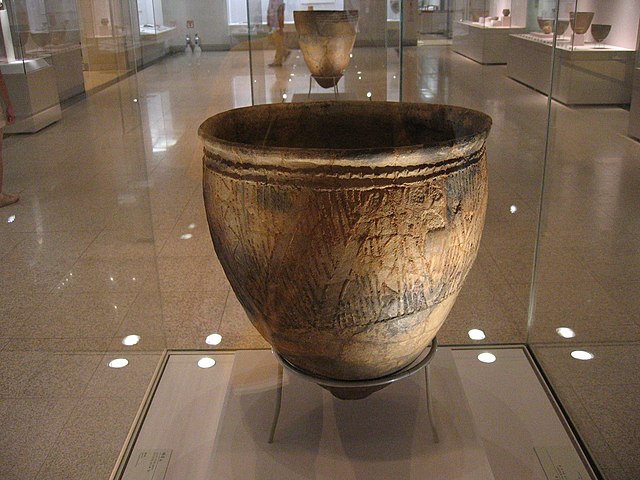Jeulmun pottery period
Korean historical period From Wikipedia, the free encyclopedia
The Jeulmun pottery period (Korean: 즐문 토기 시대) is an archaeological era in Korean prehistory broadly spanning the period of 8000–1500 BC.[1] This period subsumes the Mesolithic and Neolithic cultural stages in Korea,[2][3] lasting ca. 8000–3500 BC ("Incipient" to "Early" phases) and 3500–1500 BC ("Middle" and "Late" phases), respectively.[4] Because of the early presence of pottery, the entire period has also been subsumed under a broad label of "Korean Neolithic".[5]
| Geographical range | Korean peninsula |
|---|---|
| Period | Neolithic |
| Dates | c. 8000 – c. 1500 BC |
| Followed by | Mumun pottery period |
| Korean name | |
| Hunminjeongeum | 즐문 토기 시대 |
| Hanja | |
| Revised Romanization | Jeulmun togi sidae |
| McCune–Reischauer | Chŭlmun t'ogi sidae |
The Jeulmun pottery period is named after the decorated pottery vessels that form a large part of the pottery assemblage consistently over the above period, especially 4000-2000 BC. Jeulmun (즐문; 櫛文) means "Comb-patterned". A boom in the archaeological excavations of Jeulmun Period sites since the mid-1990s has increased knowledge about this important formative period in the prehistory of East Asia.
The Jeulmun was a period of hunting, gathering, and small-scale cultivation of plants.[6] Archaeologists sometimes refer to this life-style pattern as "broad-spectrum hunting and gathering".

Incipient Jeulmun


The origins of the Jeulmun are not well known, but raised-clay pattern Yunggimun pottery (융기문토기; 隆起文土器) appears at southern sites such as Gosan-ni in Jeju Province and Ubong-ni on the seacoast in Ulsan. Some archaeologists describe this range of time as the "Incipient Jeulmun period" and suggest that the Gosan-ni pottery dates to 10,000 BC.[2][7] Samples of the pottery were radiocarbon dated, and although one result is consistent with the argument that pottery emerged at a very early date (i.e., 10,180±65 BP [AA-38105]), other dates are somewhat later.[8] If the earlier dating holds true, Yunggimun pottery from Gosan-ni would be, along with central and southern China, the Japanese Archipelago, and the Russian Far East, among a group of the oldest known pottery in world prehistory. Kuzmin suggests that more absolute dating is needed to gain a better perspective on this notion.[9]
Early Jeulmun
The Early Jeulmun period (c. 6000-3500 BC) is characterized by deep-sea fishing, hunting, and small semi-permanent settlements with pit-houses. Examples of Early Jeulmun settlements include Seopohang, Amsa-dong, and Osan-ri.[10] Radiocarbon evidence from coastal shellmidden sites such as Ulsan Sejuk-ri, Dongsam-dong, and Ga-do Island indicates that shellfish were exploited, but many archaeologists maintain that shellmiddens (or shellmound sites) did not appear until the latter Early Jeulmun.[5]
Middle Jeulmun
Summarize
Perspective
Choe and Bale estimate that at least 14 Middle Jeulmun period (c. 3500-2000 BC) sites have yielded evidence of cultivation in the form of carbonized plant remains and agricultural stone tools.[11] For example, Crawford and Lee, using AMS dating techniques, directly dated a domesticated foxtail millet (Setaria italica ssp. italica) seed from the Dongsam-dong Shellmidden site to the Middle Jeulmun.[12] Another example of Middle Jeulmun cultivation is found at Jitam-ri (Chitam-ni) in North Korea. A pit-house at Jitam-ri yielded several hundred grams of some carbonized cultigen that North Korean archaeologists state is millet.[13][14] However, not all archaeologists accept the grains as domesticated millet because it was gathered out of context in an unsystematic way, only black-and-white photos of the find exist, and the original description is in Korean only.
Cultivation was likely a supplement to a subsistence regime that continued to heavily emphasize deep-sea fishing, shellfish gathering, and hunting. "Classic Jeulmun" or Bitsalmunui pottery (빗살무늬토기) in which comb-patterning, cord-wrapping, and other decorations extend across the entire outer surface of the vessel, appeared at the end of the Early Jeulmun and is found in West-central and South-coastal Korea in the Middle Jeulmun.
Late Jeulmun
Summarize
Perspective
The subsistence pattern of the Late Jeulmun period (c. 2000-1500 BC) is associated with a de-emphasis on exploitation of shellfish, and the settlement pattern registered the appearance of interior settlements such as Sangchon-ri (see Daepyeong) and Imbul-ri. Lee suggests that environmental stress on shellfish populations and the movement of people into the interior prompted groups to become more reliant on cultivated plants in their diets.[15] The subsistence system of the interior settlements was probably not unlike that of the incipient Early Mumun pottery period (c. 1500-1250 BC), when small-scale shifting cultivation ("slash-and-burn") was practiced in addition to a variety of other subsistence strategies. The Late Jeulmun is roughly contemporaneous with Lower Xiajiadian culture in Liaoning, China. Archaeologists have suggested that Bangudae and Cheonjeon-ri, a substantial group of petroglyph panels in Ulsan, may date to this sub-period, but this is the subject of some debate.
Kim Jangsuk suggests that the hunter-gatherer-cultivators of the Late Jeulmun were gradually displaced from their "resource patches" by a new group with superior slash-and-burn cultivation technology and who migrated south with Mumun or undecorated pottery (무문토기; 無文土器). Kim explains that the pattern of land use practiced by the Mumun pottery users, the dividing up of land into sets of slash-and-burn fields, eventually encroached on and cut off parts of hunting grounds used by Jeulmun pottery users.[16]
See also
References
Further reading
External links
Wikiwand - on
Seamless Wikipedia browsing. On steroids.
